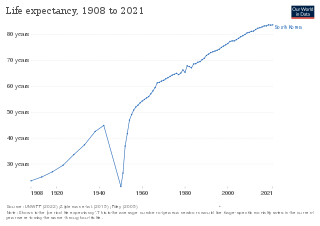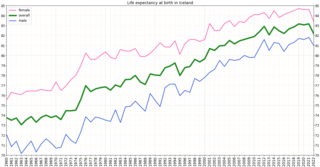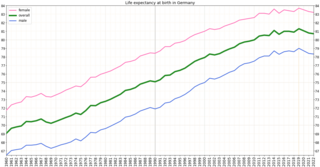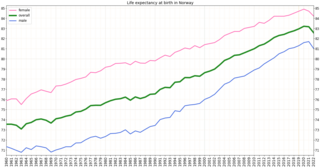
Smoking, alcohol consumption and obesity in the Republic of Ireland occur at rates higher than the OECD average.

Health in Sweden has generally improved over time, with life expectancy increasing, and is at a high level in international comparison. Life expectancy in 2021 was 84.8 years for women and 81.2 years for men and it increased 2.3 years on average from 2006 to 2019. However, the health situation varies between groups in Swedish society and equitable health has proven to be a challenge, with level of education, employment status and country of birth being factors that strongly influence health in the Swedish population. The two leading causes of death in Sweden are cardiovascular disease and cancer.

Health in Switzerland relates to a variety of issues. Namely, water and sanitation, diet and fitness, various addictions, mental fitness, communicable diseases, hygiene and the environment.

Life expectancy has been rising rapidly and South Korea ranked 3rd in the world for life expectancy. South Korea has among the lowest HIV/AIDS adult prevalence rate in the world, with just 0.1% of the population being infected, significantly lower than the U.S. at 0.6%, France's 0.4%, and the UK's 0.3% prevalence rate. South Korea has a good influenza vaccination rate, with a total of 43.5% of the population being vaccinated in 2019. A new measure of expected human capital calculated for 195 countries from 1920 to 2016 and defined for each birth cohort as the expected years lived from age 20 to 64 years and adjusted for educational attainment, learning or education quality, and functional health status was published by the Lancet in September 2018. South Korea had the sixth highest level of expected human capital with 26 health, education, and learning-adjusted expected years lived between age 20 and 64 years.

A new measure of expected human capital calculated for 195 countries from 1990 to 2016 and defined for each birth cohort as the expected years lived from age 20 to 64 years and adjusted for educational attainment, learning or education quality, and functional health status was published by the Lancet in September 2018. The Netherlands had the fourth highest level of expected human capital with 27 health, education, and learning-adjusted expected years lived between age 20 and 64 years.
A new measure of expected human capital calculated for 195 countries from 1990 to 2016 and defined for each birth cohort as the expected years lived from age 20 to 64 years and adjusted for educational attainment, learning or education quality, and functional health status was published by the Lancet in September 2018. Taiwan had the fifth highest level of expected human capital with 26 health, education, and learning-adjusted expected years lived between age 20 and 64 years.

The major causes of deaths in Finland are cardiovascular diseases, malignant tumors, dementia and Alzheimer's disease, respiratory diseases, alcohol related diseases and accidental poisoning by alcohol. In 2010, the leading causes of death among men aged 15 to 64 were alcohol related deaths, ischaemic heart disease, accident, suicides, lung cancer and cerebrovascular diseases. Among women the leading causes were breast cancer, alcohol related deaths, accidents, suicides, ischaemic heart disease and lung cancer.

A new measure of expected human capital calculated for 195 countries from 1990 to 2016 and defined for each birth cohort as the expected years lived from age 20 to 64 years and adjusted for educational attainment, learning or education quality, and functional health status was published by The Lancet in September 2018. Slovenia had the twenty-fourth highest level of expected human capital with 23 health, education, and learning-adjusted expected years lived between age 20 and 64 years.
In 2006, life expectancy for males in Cyprus was 79 and for females 82 years. Infant mortality in 2002 was 5 per 1,000 live births, comparing favourably to most developed nations.
A new measure of expected human capital calculated for 195 countries from 1990 to 2016 and defined for each birth cohort as the expected years lived from age 20 to 64 years and adjusted for educational attainment, learning or education quality, and functional health status was published by The Lancet in September 2018. Estonia had the seventeenth highest level of expected human capital with 24 health, education, and learning-adjusted expected years lived between age 20 and 64 years.

Iceland had the third-lowest crude mortality rate in Europe, at 355 per 100,000 population in 2015. It had the lowest rate of male smokers in Europe: 17%.

A new measure of expected human capital calculated for 195 countries from 1990 to 2016 and defined for each birth cohort as the expected years lived from age 20 to 64 years and adjusted for educational attainment, learning or education quality, and functional health status was published by the Lancet in September 2018. Belgium had the tenth highest level of expected human capital with 25 health, education, and learning-adjusted expected years lived between age 20 and 64 years.

Life expectancy at birth in Belarus was 69 for men and 79 for women in 2016.

Legislation on public health issues in Austria is fragmented and in some cases outdated and patchy according to the European Observatory on Health Systems and Policies.
Life expectancy in Andorra was 79.8 for men and 85.2 years for women in 2010.

A new measure of expected human capital calculated for 195 countries from 1990 to 2016 and defined for each birth cohort as the expected years lived from age 20 to 64 years and adjusted for educational attainment, learning or education quality, and functional health status was published by The Lancet in September 2018. Latvia had the twenty-first highest level of expected human capital with 23 health, education, and learning-adjusted expected years lived between age 20 and 64 years.

Germany ranked 20th in the world in life expectancy in 2014 with 76.5 years for men and 82.1 years for women. It had a very low infant mortality rate, and it was eighth place in the number of practicing physicians, at 3.3 per 1,000 people.

Health in Norway, with its early history of poverty and infectious diseases along with famines and epidemics, was poor for most of the population at least into the 1800s. The country eventually changed from a peasant society to an industrial one and established a public health system in 1860. Due to the high life expectancy at birth, the low under five mortality rate and the fertility rate in Norway, it is fair to say that the overall health status in the country is generally good.
Montenegro is a country with an area of 13,812 square kilometres and a population of 620,029, according to the 2011 census. The country is bordered by Croatia, the Adriatic Sea, Bosnia, Herzegovina, Serbia, Kosovo and Albania. The most common health issues faced are non-communicable diseases accounting for 95% of all deaths. This is followed by 4% of mortality due to injury, and 1% due to communicable, maternal, perinatal and nutritional conditions. Other health areas of interest are alcohol consumption, which is the most prevalent disease of addiction within Montenegro and smoking. Montenegro has one of the highest tobacco usage rates across Europe. Life expectancy for men is 74 years, and life expectancy for women is 79.

A new measure of expected human capital calculated for 195 countries from 1990 to 2016 and defined for each birth cohort as the expected years lived from age 20 to 64 years and adjusted for educational attainment, learning or education quality, and functional health status was published by the Lancet in September 2018. Luxembourg had the eighth highest level of expected human capital with 25 health, education, and learning-adjusted expected years lived between age 20 and 64 years.















